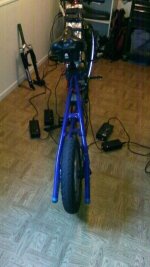hypertoric_amplituhedron
100 W
Someone asked a question about charging 2 batteries with one charger,. It prompted me to ask a similar question, but with other specifics. I can build bikes, but I'm a bit electro-dumb.
I have the EM3ev 14s7p hardcase rectangle pack. It has ~70 cycles on it. Just bought a second one, exactly identical. I want double the range (2x the fun!) I was getting before.
What I want to do:
Strap down and connect both in parallel (using XT90 parallel harness) to the controller of my X1 pro, cyclone 3000, or bbshd.
Any issues here? With Discharging?
How about disconnecting both, and charging individually? I plan on getting an adjustable 2-12a charger, that feeds through the XT90 on the battery, instead of the low amp Anderson. The Smart BMS allows this.
If I keep both connected the whole time I use them, any issues with charging, then? I know it's not ideal having 70 cycles on one, and 0 on the other. I need to pass this by you guys as a sanity check, before blowing anything up.
Thanks in advance!
I have the EM3ev 14s7p hardcase rectangle pack. It has ~70 cycles on it. Just bought a second one, exactly identical. I want double the range (2x the fun!) I was getting before.
What I want to do:
Strap down and connect both in parallel (using XT90 parallel harness) to the controller of my X1 pro, cyclone 3000, or bbshd.
Any issues here? With Discharging?
How about disconnecting both, and charging individually? I plan on getting an adjustable 2-12a charger, that feeds through the XT90 on the battery, instead of the low amp Anderson. The Smart BMS allows this.
If I keep both connected the whole time I use them, any issues with charging, then? I know it's not ideal having 70 cycles on one, and 0 on the other. I need to pass this by you guys as a sanity check, before blowing anything up.
Thanks in advance!


